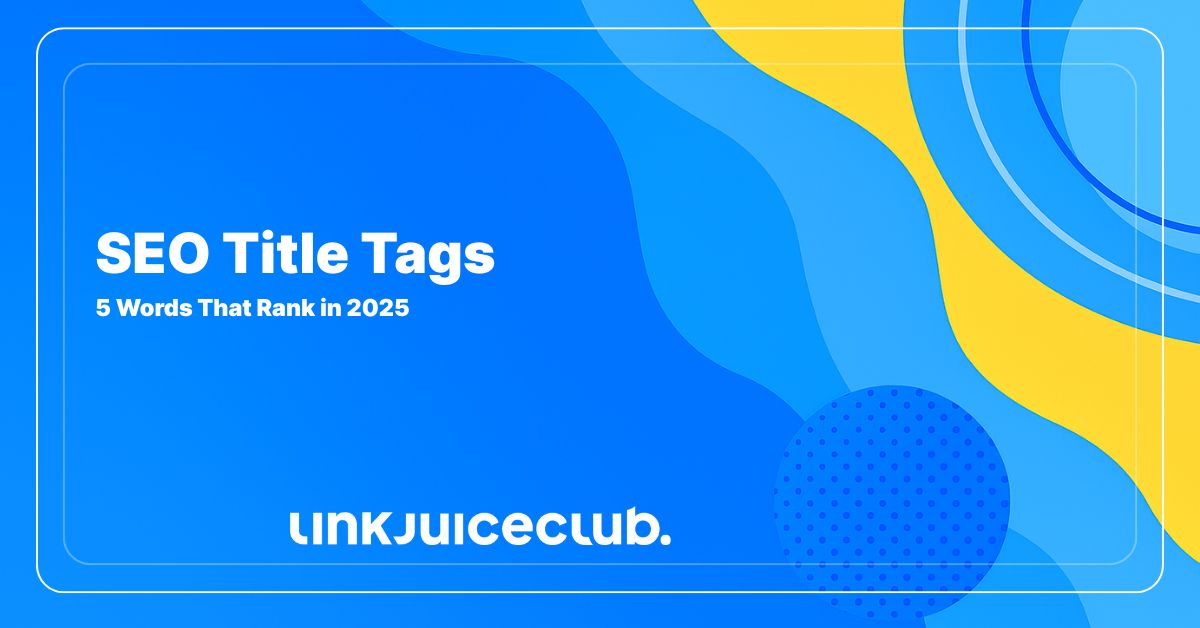
SEO Title Tags: 5 Words That Rank in 2025
A well-behaved title tag walks into a search engine and walks out wearing a crown. That is the SEO equivalent of a successful handshake. SEO title tags, those small but mighty HTML headers, hold influence in how Google and friends understand what lives on a web page. Marketers and SEOs stare at them longer than weather forecasts. That happens for good reason. These titles affect rankings, user clicks and, most importantly, bragging rights in the team Slack.
Using thousands of top keywords and tens of thousands of words from high-ranking titles, researchers scraped, cleaned and analysed data from current search engine results. Prepositions were tossed aside like cold chips. The aim remained precise: identify which words genuinely dominate the title tag real estate in 2025.
Those keen on crafting better content or supervising a content team full of caffeine-fuelled optimists gain much from understanding this.
Short Tags Win First Place
Length isn’t just a vanity metric. When it comes to SEO title tags, the shorter versions clearly outperform their long-winded counterparts. Tags sitting comfortably between 15 and 40 characters deliver stronger engagement, collecting 8.6 percent more clicks than titles that overshoot the character count. That’s the kind of return usually reserved for well-placed pub bets.
Compact titles keep things sharp and direct. Users scan, absorb and decide within seconds. Short tags meet them halfway.

There’s another winning move. When a title tag includes a question word – such as “what,” “how,” or “when” – the click rate jumps by an extra 14.1 percent. These question-based titles act like a pointy stick to curiosity. People search with questions in their heads, so seeing a matching phrase feels like getting a quick answer from a clever mate.
Combined, short tags and question words deliver better visibility, clearer relevance and stronger user response.
Winning formulas:
- What is the best VPN for 2025? ✅
- How to make iced coffee at home ☕
- Best free PDF editor online 📄
What Happens Inside a Title Tag
The SEO title tag functions as a label for a page. It appears in browser tabs, search engine listings and social previews. Its job is to tell machines and humans exactly what the page contains, using the least amount of words possible. Google peeks at it to grasp intent. Users glance at it to decide whether to click.
The average length for a good SEO title tag falls under 60 characters. That ensures full visibility in Google’s blue link showcase. Tools like Ahrefs and SEMRush can reveal what ranks and why. When researchers collected over 6,600 top-ranking titles and stripped them for parts, the most-used words came marching out like contestants on a quiz show.
1. Free 🎁
People spot “free” like seagulls spot chips. The word jumps off the screen. Marketers find it useful across many types of content, from template downloads to product trials. Including “free” in an SEO title tag increases interest and encourages clicks. When “free” combines with other high-utility terms like “tools,” “templates” or “courses,” the result becomes more clickable than a big red button.
Many high-performing titles use “free” near the start. This prioritises the appeal and matches user queries looking for no-cost options.
Common real-world formats:
- Free Invoice Generator for Freelancers
- Free Excel Templates for Budgeting
- Best Free Online Courses for Beginners
Searches containing the word “free” carry high user intent. They often reflect someone trying to solve a problem with minimal friction.
Effective use of “free” includes:
- Software and app listings
- Educational content
- Downloadable resources
2. How 🛠️
The word “how” enters with a toolbox. Its usage is functional. It works in phrases like “how to,” “how does” or “how is.” This indicates instructional content and supports Google’s understanding of tutorial intent. Searchers asking how to do something receive step-by-step instructions in return. Sites using structured data like HowTo schema may receive enhanced presentation in the SERP.
Including “how” in a title sets up clear expectations. The user anticipates learning something actionable. It performs well when paired with verbs such as “make,” “install,” “write,” or “build.”
Frequently observed patterns:
- How to Install WordPress on Bluehost
- How Is Honey Made?
- How to Create a Gantt Chart in Excel
Pages that promise a process or teach a method benefit from beginning their SEO title tags with “how.” This matches a dominant user behaviour — asking for help.
Situations perfect for “how”:
- Guides and tutorials
- Product usage instructions
- Skill-building content
3. Current Year 📅
Among all words, numbers did something clever. They ranked first. In particular, the current year, 2025, appeared more often than any word used in the dataset. Including the year demonstrates to users that a piece of content reflects current standards, recent trends or updated data.
This works especially well for listicles, product comparisons and how-to guides. SEO title tags that include the year perform well in seasonal searches, annual roundups and tech or financial updates. The number signals freshness, which encourages clicks.
Popular title layouts using 2025:
- Best Tax Filing Software 2025
- Top Laptops for Students in 2025
- Updated Social Media Calendar 2025
The structure appeals to users looking for up-to-date recommendations. This aligns with how Google assesses the recency of content, favouring updates within the last couple of years.
When to use the year:
- Time-sensitive content
- Competitive product comparisons
- Recurring calendar-based queries
4. What ❓
The question word “what” appears frequently in SEO title tags because it speaks to intent. Users type “what is” queries when seeking clear, introductory or definitional content. Google understands these queries as informational, and pages that reflect this structure appear more often in People Also Ask boxes and Featured Snippets.
Including “what” provides context, simplicity and precision. Pages that explain terms, concepts or features benefit from the structure.
Examples from real title tags:
- What Is a Roth IRA?
- What Happens in a Solar Eclipse
- What Is the Mediterranean Diet Plan
The phrase “what is” also provides opportunities for structured data via FAQPage markup. This increases a page’s chance of being featured with expanded results.
Best use cases for “what”:
- Definitions
- Concept introductions
- Explainer articles
5. Day ☀️
In a sea of software, calculators, courses and tools, the word “online” shows exactly where something operates. This matters more than expected. It draws attention to availability, immediacy and digital delivery. Including “online” in SEO title tags boosts precision and context.
Searches that involve services often include this word. Whether a user looks for an online notepad, grammar checker or design tool, this keyword aligns the page with query intent. The format benefits SaaS businesses, tool makers and platform aggregators.
Live examples from top-ranking titles:
- Free Online Word Counter Tool
- Online GIF Compressor – Fast & Simple
- Best Online Coding Courses for Beginners
Use cases that shine with “online”:
- Digital services
- Web-based tools
- Internet-hosted platforms
This word carries weight for any product that lives on the internet. It improves match rate with user queries and filters intent precisely.
Strategic Insights for Top SEO Title Words
Each of the five high-performing words in SEO title tags brings more than charm. Their success depends on how they pair with schema, where they land in the title, and which words accompany them. Understanding these mechanics helps turn a solid tag into a ranking machine.
The table below breaks down practical attributes for each keyword, including the structured data types they align with, the SERP range they tend to occupy, their most common supporting words, and the most effective position they hold within a title.
| Word | Schema Type | Avg SERP Position | Companion Words | Ideal Placement |
| Free | Offer, Product, SoftwareApplication | 1–4 | tool, template, download, course | Start |
| How | HowTo | 1–3 | to, guide, steps, tutorial | Start |
| 2025 | None | 2–5 | best, top, updated, list | End |
| What | FAQPage | 1–2 | is, does, means, happens | Start |
| Online | SoftwareApplication, Service | 2–6 | free, platform, tool, calculator | Middle or End |
Title Length and Word Positioning
Search engines respect structure. A clean SEO title tag falls within 50 to 60 characters. This keeps the full title visible in results and prevents cut-off endings. Every character counts. Placing the most valuable keywords at the beginning improves visibility and relevance.
Writers craft effective tags by blending the above top words with niche terms from their topics. A title like “Free Logo Maker for Startups 2025” uses three of the top five and serves high user intent.
Checklist for crafting tags:
- Keep it under 60 characters
- Start with the core keyword
- Include time, value or instruction words
- Match intent with phrasing
SEO Title Tags in Structured Content
Structured data amplifies the power of SEO title tags. Tags like “how” and “what” can be enhanced using schema markups. Google uses this to show step lists, FAQs and other rich elements in the search results.

The presence of these common words in structured results shows alignment between user behaviour and machine understanding. When a tag says “how to build a shed,” and the page contains an actual guide, structured data can showcase the steps directly in the results.
Schema types that complement top words:
- FAQPage (for “what” queries)
- HowTo (for “how” guides)
- Event (for “day” mentions)
Reinforcement Through Examples 🎓
Using examples from high-ranking titles cements understanding. Each word listed here matches actual user behaviour. The data speaks without decoration. Users search for what they need. Title tags either match that need or fade into obscurity.
Repeating successful patterns keeps content visible. The structure of “How to [verb] in [year]” brings together the instructional form, time-based relevance and purpose. “Free [noun] Generator Online” gives value with context. The word choice within SEO title tags shapes what appears in search and who clicks.
Observed success patterns:
- [Word] + [Noun] + 2025
- How to + [Verb Phrase]
- Free + [Tool Type] + Online
- What is + [Concept]
- [Holiday Name] + [Date or Activity]
These reflect content that consistently earns top placement in current search results.
The Function of Word Choice in SEO Title Tags
The humble SEO title tag wields quiet authority. Inside it, single words can push a page higher or keep it locked in the digital basement. The top five words identified in this analysis appear frequently in content that earns position, attention and traffic.
Writers working on content strategy benefit from mastering their use. Precision in word choice, placement, and structure results in higher search performance. The data confirms that these terms function effectively in a variety of industries. They connect content to query, signal relevance to Google, and invite the user to click.
This collection of observed patterns, proven word choices and formatting tactics provides a toolkit for any SEO expert updating or building high-performing pages. They guide the expression of that understanding in the format that Google interprets best. When used wisely, these words elevate content into the blue links that rule the page.





